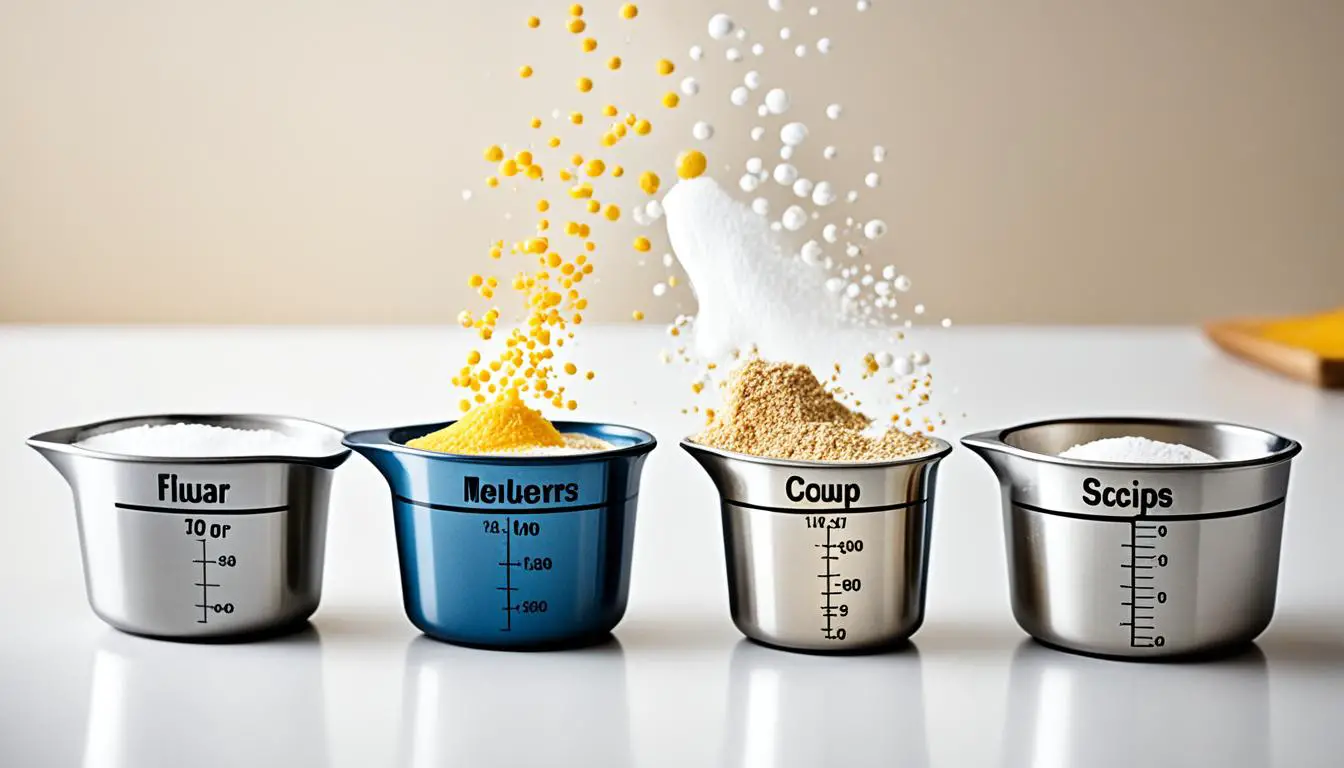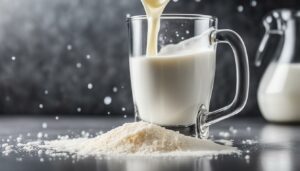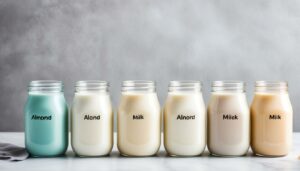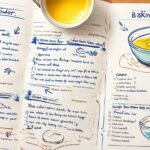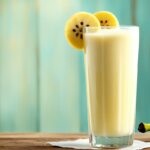Originally posted on February 10, 2024 @ 7:57 am
Have you ever come across a recipe that calls for a cup of flour or a cup of milk and wondered how big that actually is? Understanding cup sizes in recipes is crucial for successful cooking and baking. Let’s delve into the measurements of a cup in cooking and unveil the secrets to accurate ingredient proportions.
When it comes to measuring ingredients in recipes, all cooking ingredients are measured with a metric-style measuring cup set, where 1 cup is equal to 250 ml. These sets are readily available and recommended for precise measurements. Measuring cups typically come in sizes such as 1 cup, 1/2 cup, 1/3 cup, 1/4 cup, and 1/8 cup, allowing you to measure different quantities with ease.
Accurate measuring of both dry and liquid ingredients is vital. Dry ingredients like flours, sugars, and spices should be measured by filling the measuring cup or spoon up to the brim and leveling it off with the back edge of a knife or spatula. Some dry ingredients, like granulated sugar, aren’t very compressible, so volume measures remain consistent. However, others, like flour, can vary in weight depending on how they are packed. Our recipes specify whether to use compressed or uncompressed quantities for better accuracy.
When measuring liquid ingredients, opt for a measuring jug for quantities larger than a cup. For smaller quantities, rely on tablespoons, teaspoons, and smaller cups, such as 1/2 cup, 1/4 cup, and 1/3 cup. To ensure precise measurements, always check the liquid level at eye level. For conversions between cups and milliliters (mL) or liters, refer to the handy conversion chart.
Converting cup measurements may be necessary when encountering recipes that use different measurement units. Keep in mind that U.S. liquid cups differ from U.S. dry cup measurements. Dry ingredients should be measured with a dry measuring cup, while liquid ingredients can be directly converted to metric milliliters (mL). Be aware that recipes from the UK may have different cup measurements altogether.
Contents
- 1 Measuring Dry Ingredients
- 2 Measuring Liquid Ingredients
- 3 Converting Cup Measurements
- 4 Common Conversions Chart
- 5 Where to Buy Measuring Cup Sets
- 6 Understanding Kitchen Measurements
- 7 Cup Sizes in Metric and Imperial Systems
- 8 Measuring Temperature and Gas Marks
- 9 Scaling Recipes to Servings
- 10 Importance of Accurate Measurements
- 11 Conclusion
- 12 FAQ
- 12.1 How big is a cup in recipes?
- 12.2 How do I measure dry ingredients?
- 12.3 How do I measure liquid ingredients?
- 12.4 How do I convert cup measurements in recipes?
- 12.5 What is the common conversions chart for cup measurements?
- 12.6 Where can I buy measuring cup sets?
- 12.7 What are kitchen measurements and how are they used?
- 12.8 How are cup sizes different in the metric and imperial systems?
- 12.9 How do I measure temperature and gas marks in recipes?
- 12.10 How do I scale recipes to serve more or fewer people?
- 12.11 Why are accurate measurements important in cooking?
- 12.12 What is the importance of understanding cup sizes in recipes?
- 13 Source Links
Key Takeaways:
- 1 cup in recipes equals 250 ml, providing a standard metric reference.
- Use a metric-style measuring cup set with sizes like 1 cup, 1/2 cup, 1/3 cup, 1/4 cup, and 1/8 cup for accurate measurements.
- Ensure to measure dry ingredients by filling the cup and leveling it off, while liquid ingredients should be measured in a measuring jug or smaller cups.
- Conversions between cups and milliliters (mL) may be needed for different recipes or measurement systems.
- Accurate measurements are crucial for consistent and successful cooking and baking outcomes.
Measuring Dry Ingredients
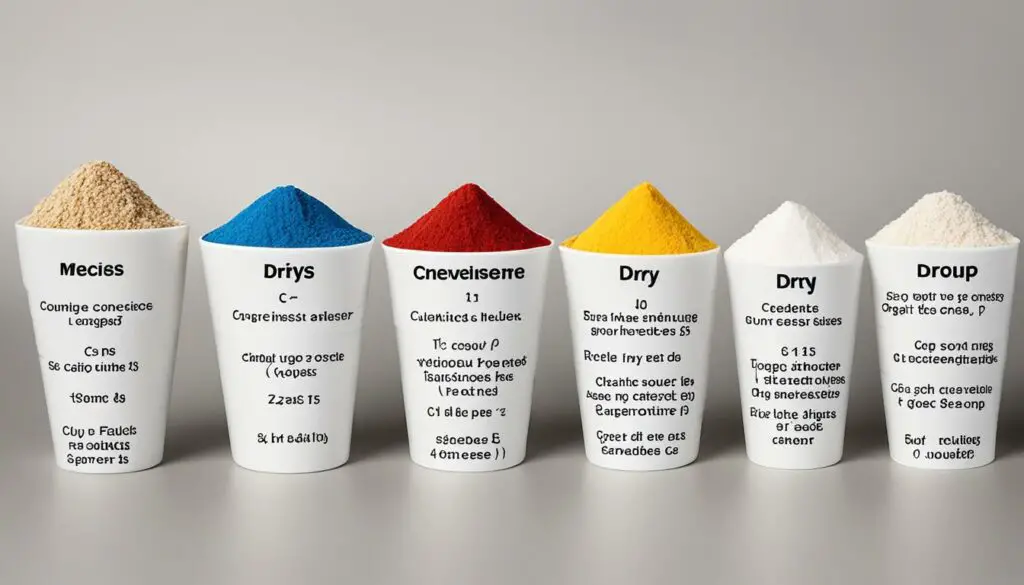
When it comes to measuring dry ingredients like flours, sugar, and spices, the key is to achieve accurate measurements for successful cooking and baking. Here are some essential tips to help you measure dry ingredients correctly:
- Fill the measuring cup or spoon: When measuring dry ingredients, fill the measuring cup or spoon with the ingredient up to the brim. Use a spoon or spatula to level off the excess by scraping it with the back edge of a knife. This ensures that you have the precise amount of the ingredient required in the recipe.
- Consider the compressibility: It’s important to note that some dry ingredients, like granulated sugar, are not very compressible, meaning their volume measures consistently. However, others, like flour, can vary in weight depending on how they are packed. This can affect the overall texture and consistency of your final dish. Our recipes mention whether to use compressed or uncompressed quantities for better accuracy, so be sure to follow the instructions for the best results.
By following these simple steps, you’ll be able to measure dry ingredients accurately and achieve consistent and delicious results in your cooking and baking endeavors.
| Dry Ingredient | Compressed Volume (Cups) | Uncompressed Volume (Cups) | Grams (Approx.) |
|---|---|---|---|
| All-Purpose Flour | 1 cup | 1 cup + 1 tablespoon | 120 g |
| Granulated Sugar | 1 cup | 1 cup | 200 g |
| Brown Sugar (Packed) | 1 cup | 1 cup | 220 g |
| Baking Powder | 1 tablespoon | 1 tablespoon | 12 g |
| Salt | 1 teaspoon | 1 teaspoon | 6 g |
Measuring Liquid Ingredients
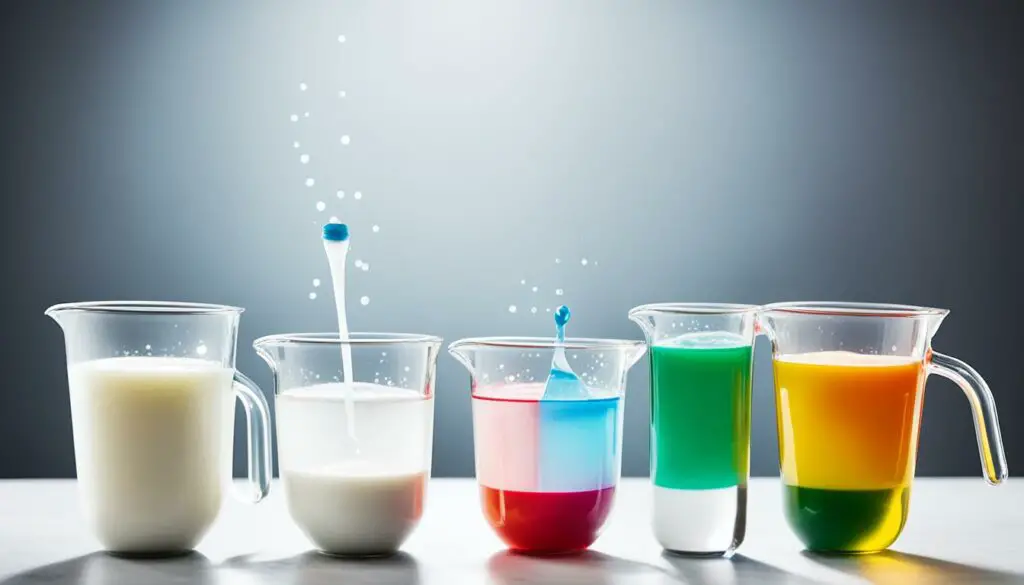
When it comes to measuring liquid ingredients in recipes, accuracy is key. Using the right tools and techniques will ensure that your dishes turn out just the way you want them. Here are some tips:
Using a Measuring Jug
If you need to measure quantities larger than a cup, it’s best to use a measuring jug. These handy kitchen tools are designed specifically for measuring liquids. They often have clear markings on the side, making it easy to see the exact volume. To ensure precise measurements, make sure to check the liquid level at eye level, as this helps eliminate any potential discrepancies.
Smaller Quantities
For smaller quantities of liquid ingredients, such as tablespoons, teaspoons, or smaller cups like 1/2 cup, 1/4 cup, or 1/3 cup, you can use measuring spoons or smaller measuring cups. These tools are specially calibrated to provide accurate measurements for smaller portions, ensuring that your recipes are perfectly balanced.
Here’s a helpful conversion chart for liquid measurements:
| Cups | Milliliters (mL) | Liters (L) |
|---|---|---|
| 1/4 cup | 60 mL | 0.06 L |
| 1/3 cup | 80 mL | 0.08 L |
| 1/2 cup | 125 mL | 0.125 L |
| 1 cup | 250 mL | 0.25 L |
| 2 cups | 500 mL | 0.5 L |
| 4 cups | 1000 mL | 1 L |
With this chart, you can easily convert the amount of liquid required in a recipe from cups to milliliters or liters, depending on your specific needs.
Remember, accurate measurements are crucial for achieving the desired results in your cooking. Taking the time to measure your liquid ingredients properly will help ensure that your recipes turn out just as delicious as you imagined.
Converting Cup Measurements

When following recipes, it’s common to encounter different measurement units, which may require converting cup measurements. This is especially important when recipes list measurements in milliliters (mL) instead of cups. Additionally, it’s crucial to understand that U.S. liquid cups differ from U.S. dry cup measurements.
Dry ingredients:
When measuring dry ingredients like flour, sugar, or cocoa powder, it’s necessary to use a dry measuring cup. These cups are specifically designed to provide accurate measurements for dry ingredients, ensuring consistent results in your baked goods or other recipes. Remember to level off the dry ingredients with a straight edge, such as the back of a knife, for precise measuring.
Liquid ingredients:
Liquid ingredients, on the other hand, can be directly converted to metric milliliters (mL) without the need for any additional calculations. Using a liquid measuring cup or a digital kitchen scale with a built-in liquid conversion feature can simplify this process and help you achieve accurate measurements. Remember to refer to the recipe for the specific measuring method and cup size.
UK cup measurements:
It’s important to note that recipes from the UK may have different cup measurements compared to those in the U.S. or other countries. If you’re using a recipe from the UK, it’s advisable to convert the measurements to the appropriate cup size for your region or use a reliable conversion chart.
Converting cup measurements allows you to adapt recipes to suit your preferred units or to ensure consistency when using recipes from different regions. Understanding the differences between dry and liquid cup measurements and being aware of the variations in cup sizes can greatly contribute to the success of your culinary endeavors.
Common Conversions Chart
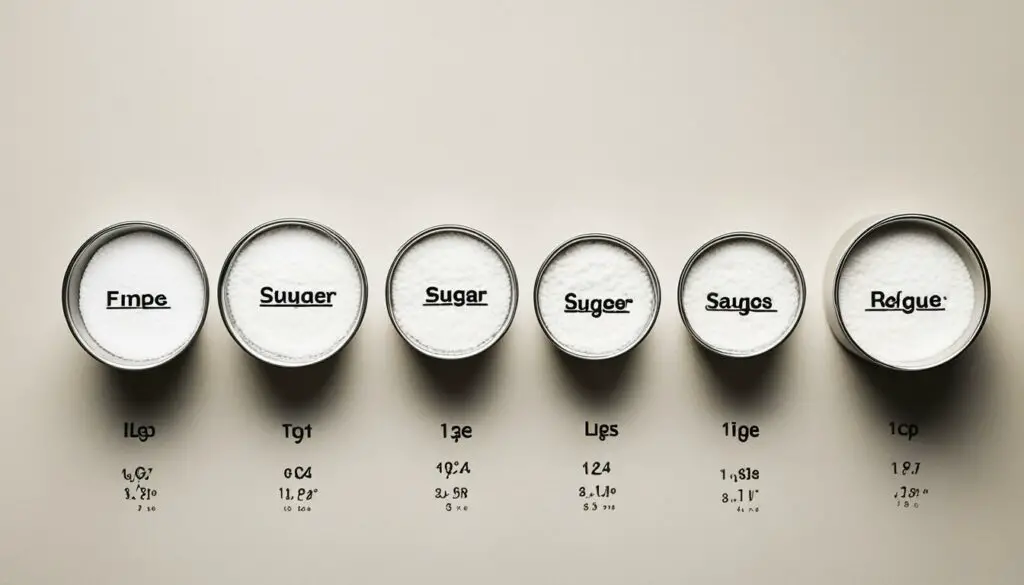
Understanding cup measurements is crucial in cooking and baking. It’s helpful to know the conversions from cups to other common measurements like tablespoons and teaspoons. This chart provides quick and accurate conversions for different quantities:
| Cups | Tablespoons | Teaspoons |
|---|---|---|
| 1 | 16 | 48 |
| 1/2 | 8 | 24 |
| 1/3 | 5.3 | 16 |
| 1/4 | 4 | 12 |
| 1/8 | 2 | 6 |
This chart allows you to convert accurately when adjusting recipes or following ones that use different measurements. It’s especially handy when you only have measuring spoons or need smaller quantities for your recipe.
Remember, these conversions are based on the standard cup size of 1 cup equaling 250 ml. Keep this in mind when working with recipes that use cups as their primary measurement unit.
Tips for Using the Conversion Chart:
- Always level off ingredients when measuring for accurate results.
- When converting to tablespoons or teaspoons, round up or down to the nearest whole number depending on your preference.
- Use the chart to adjust recipes according to your desired serving size.
By utilizing this conversion chart, you can confidently navigate recipes and ensure accurate measurements, producing delicious dishes every time.
Where to Buy Measuring Cup Sets
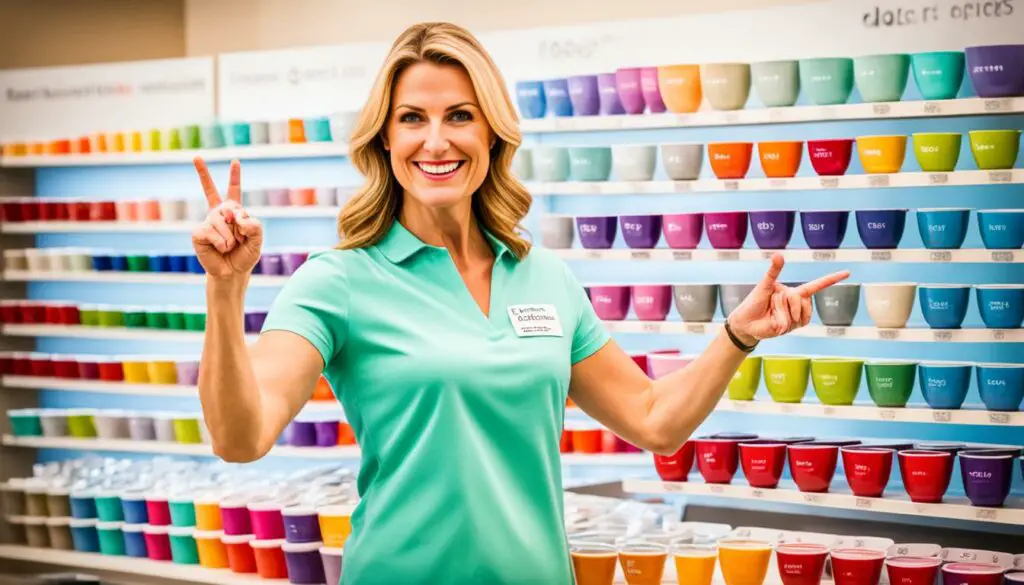
Measuring cup sets are essential tools for accurate measurements in recipes. Whether you’re a seasoned chef or an amateur cook, having a reliable set of measuring cups is a must-have in your kitchen. But where can you buy these indispensable tools? Fortunately, there are various options available to purchase measuring cup sets.
You can start your search for measuring cup sets by visiting local utensil stores. These stores often carry a wide range of kitchen essentials, including measuring cups. The advantage of shopping at a physical store is that you can see and feel the product before making a purchase. Additionally, you can seek guidance from the store staff who can provide recommendations based on your specific needs.
If you prefer the convenience of online shopping, there are numerous online stores that offer a vast selection of measuring cup sets. Online marketplaces like Amazon, eBay, and Walmart have a wide range of options to choose from. These platforms allow you to compare different brands, read customer reviews, and conveniently have the measuring cup set delivered to your doorstep.
“Having a measuring cup set is like having a reliable assistant in the kitchen. It ensures that you get the precise measurements needed for your recipes. It’s an essential investment for any cooking enthusiast!”
When purchasing a measuring cup set, it’s recommended to opt for a metric-style measuring cup set. This type of measuring cup set aligns with the standard cup size mentioned in recipes, which is 1 cup equal to 250 ml.
To make your shopping experience even more pleasant, here’s a table showcasing some popular options for purchasing measuring cup sets:
| Online Store | Physical Store | Price Range |
|---|---|---|
| Amazon | Bed Bath & Beyond | $10 – $30 |
| Walmart | KitchenAid Store | $5 – $20 |
| Target | Williams Sonoma | $8 – $25 |
Whether you choose to buy from an online store or a physical store, make sure to read product descriptions and customer reviews to ensure you’re purchasing a high-quality measuring cup set that meets your requirements. Having a reliable measuring cup set will not only enhance your cooking experience but also contribute to more consistent and successful culinary creations.
Understanding Kitchen Measurements
When it comes to cooking, understanding kitchen measurements is key to creating delicious and consistent dishes. In the culinary world, measurements can be categorized into weight and volume. Volume measurements are commonly used for liquids and smaller ingredients, while weight measurements are used for larger ingredients. Let’s explore these measurements in more detail:
Volume Measurements
Volume measurements are typically used for liquids and small ingredients like spices. Teaspoons, tablespoons, and cups are the most common units of measurement for volume. Here’s a breakdown of each:
- Teaspoon (tsp): Equivalent to approximately 5 milliliters (ml)
- Tablespoon (tbsp): Equivalent to approximately 15 milliliters (ml) or 3 teaspoons
- Cup: Equivalent to approximately 250 milliliters (ml) or 16 tablespoons
When measuring volume, it’s important to use the correct measuring tools. Measuring spoons are perfect for smaller quantities, while a measuring cup is ideal for larger volumes. Remember to level off ingredients when measuring to ensure accuracy.
Weight Measurements
Weight measurements are commonly used for larger ingredients like flour, sugar, and meat. In the kitchen, ounces (oz) and pounds (lb) are the most frequently used units of weight. Here’s a breakdown of each:
- Ounce (oz): Equivalent to approximately 28 grams (g)
- Pound (lb): Equivalent to approximately 454 grams (g) or 16 ounces
When measuring weight, it’s essential to use a kitchen scale for accurate results. This is particularly important for baking, where precise measurements can significantly impact the final outcome.
Tip: Measuring spoons can be used for both dry and liquid ingredients, making them versatile tools in the kitchen.
| Volume Measurements | Weight Measurements |
|---|---|
| Teaspoon (tsp) | Ounce (oz) |
| Tablespoon (tbsp) | Pound (lb) |
| Cup |
Understanding kitchen measurements allows you to follow recipes accurately and achieve consistent results. Whether you’re measuring volume or weight, using the right tools and techniques will help you become a master in the kitchen.
Cup Sizes in Metric and Imperial Systems
When it comes to cup sizes in cooking, there can be variations between the metric and imperial systems. Understanding these differences is crucial for accurately following recipes that specify cup measurements from different systems.
In the metric system, 1 cup is equal to 250 ml. This standard measurement is widely used in many countries, including most of Europe and Australia. Metric cup sizes are convenient for precise measurements, especially when using milliliters as a unit of volume.
On the other hand, the imperial system, predominantly used in the United States, defines 1 cup to be approximately 236.6 ml. While the difference between the metric and imperial cup sizes may seem small, it can affect the overall accuracy of your recipes if conversions are not made correctly.
When using recipes from different systems, it’s important to take note of the specified cup measurements and convert them accordingly. Below is a table illustrating the conversion between metric and imperial cup sizes:
| Metric Cup Size | Imperial Cup Size |
|---|---|
| 1 cup | 0.962 cups |
| 1/2 cup | 0.481 cups |
| 1/3 cup | 0.321 cups |
| 1/4 cup | 0.240 cups |
| 1/8 cup | 0.120 cups |
By referring to this conversion table, you can ensure accurate measurements and successful results when adapting recipes between the metric and imperial systems. Remember to pay attention to your specific recipe’s instructions to achieve the desired outcome.
Measuring Temperature and Gas Marks
In the world of cooking, accurate temperature measurement is crucial for achieving the perfect dish. Different temperature units and gas marks are used in recipes to guide you through the cooking process. Understanding how to measure temperature correctly ensures that your oven is set at the right heat level, allowing your food to cook evenly and to perfection.
Whether you’re baking a cake, roasting a chicken, or simmering a sauce, knowing the appropriate temperature is key. Here’s a conversion chart that provides equivalents for temperature measurements in Celsius, Fahrenheit, and gas marks:
| Celsius | Fahrenheit | Gas Mark |
|---|---|---|
| 100°C | 212°F | 1/4 |
| 130°C | 250°F | 1/2 |
| 150°C | 300°F | 2 |
| 180°C | 350°F | 4 |
| 200°C | 400°F | 6 |
| 220°C | 425°F | 7 |
| 230°C | 450°F | 8 |
| 240°C | 475°F | 9 |
| 250°C | 480°F | 10 |
With this information, you can confidently set your oven temperature according to the recipe’s instructions, whether it calls for a specific gas mark or a temperature in Celsius or Fahrenheit.
“Accurate temperature measurement is the secret ingredient to cooking success. With the right heat, your culinary creations will be nothing short of perfection.”
Scaling Recipes to Servings
When you have a recipe that doesn’t quite match the number of servings you need, scaling it up or down is the solution. Whether you’re hosting a large gathering or cooking for a small dinner party, adjusting the ingredient quantities is essential. By understanding the measurements and proportions, you can easily make accurate adjustments and ensure that each dish is perfectly portioned.
Scaling recipes requires some basic math and a good grasp of the original recipe’s ratios. A key tool in this process is the conversion chart, which provides the necessary measurements for different quantities. With the help of this chart and your knowledge of cup sizes, you can confidently scale recipes to serve more or fewer people without sacrificing taste or quality.
Step-by-Step Guide to Scaling Recipes
- Begin by determining the original recipe’s yield or the number of servings it’s designed for.
- Decide on the desired number of servings you want to achieve.
- Calculate the scaling factor by dividing the desired number of servings by the original yield. This will give you the proportion by which you need to adjust the recipe.
- Take each ingredient in the original recipe and multiply its quantity by the scaling factor. Round off the values to the nearest whole number or appropriate measurement unit.
- Follow the newly adjusted ingredient quantities and proceed with the recipe as usual.
Scaling recipes not only helps you accommodate different serving sizes but also allows you to experiment with flavors and ingredients. By adjusting the proportions, you can create variations of your favorite dishes and adapt them to suit any occasion. So whether you’re cooking for a cozy dinner for two or a crowd-pleasing feast, scaling recipes ensures that everyone gets a taste of perfection.
In the next section, we will explore the importance of accurate measurements in achieving the perfect dish and honing your cooking skills.
Importance of Accurate Measurements
Accurate measurements are the backbone of successful cooking and baking. Whether you’re a seasoned chef or just starting out in the kitchen, ensuring precise measurements is key to achieving the desired results. From measuring the perfect amount of flour for a fluffy cake to getting the right balance of spices in a savory dish, accurate cup measurements are essential in perfecting your cooking skills.
Using the correct cup sizes as mentioned in recipes provides consistency and avoids any potential issues with the final outcome. Accurate measurements not only help you achieve the desired taste and texture but also contribute to the overall presentation of your dishes. Whether you’re baking a delicate soufflé or making a flavorful sauce, accurate measurements make a world of difference.
When it comes to baking, precise ratios are everything. A slight variation in measurements can impact the rise, texture, and taste of your baked goods. Too much or too little flour, sugar, or leavening agent can lead to flat cakes or dense cookies. On the other hand, accurately measuring ingredients ensures that your baked treats turn out light, fluffy, and perfectly balanced in flavor.
“Baking is both an art and a science, and accurate measurements are the foundation of any successful creation.” – Chef Emily Thompson
Accurate cup measurements also allow you to replicate your favorite recipes with consistency. When you measure ingredients correctly, you can confidently recreate your signature dishes, delighting your family and friends every time.
Tips for Accurate Measurements
- Use a sturdy and reliable set of measuring cups and spoons.
- Fill the measuring cup or spoon to the brim and level it off for dry ingredients.
- For liquids, use a clear measuring jug and ensure the liquid reaches the correct line at eye level.
- Follow the recipe instructions precisely and avoid approximations.
- Store your ingredients properly to maintain their consistency and prevent any alterations in measurements.
By focusing on accurate cup measurements in your baking and cooking, you’ll be well on your way to mastering culinary skills and creating delectable dishes that impress every time.
Conclusion
Understanding cup sizes in recipes is crucial for achieving precise measurements and better cooking outcomes. A standard cup size in recipes is equivalent to 250 ml, and using measuring cups and spoons correctly ensures accurate ingredient measurements. By following recipes and measuring ingredients accurately, you can confidently create delicious dishes.
Accurate measurements are especially important in baking, where precise ratios impact the texture and taste of the final product. Whether you are measuring dry ingredients like flour and sugar or liquid ingredients like milk and water, using the appropriate measuring tools ensures consistency in your cooking.
Measuring cups can easily be purchased from local utensil stores or online, enabling you to have the essential tools for accurate measurements in your kitchen. Remember to differentiate between dry and liquid measuring cups, as they are designed for specific ingredients.
Mastering cup measurements in recipes not only improves your culinary skills but also allows you to confidently scale recipes and adjust ingredient quantities to serve more or fewer people. So, embrace the world of precise measurements, and let your cooking skills shine!
FAQ
How big is a cup in recipes?
In cooking, 1 cup is equal to 250 ml. It is a metric-style measuring cup that is commonly used for measuring ingredients in recipes.
How do I measure dry ingredients?
To measure dry ingredients like flour, sugar, and spices, fill the measuring cup or spoon with the ingredient up to the brim and level it with the back edge of a knife or spatula for accuracy.
How do I measure liquid ingredients?
For precision in measuring liquid ingredients, use a measuring jug for larger quantities and check it at eye level. For smaller quantities, use tablespoons, teaspoons, or smaller cups.
How do I convert cup measurements in recipes?
To convert cup measurements in recipes, use a conversion chart. Different measurements can be converted to tablespoons, teaspoons, milliliters, or liters, depending on the recipe.
What is the common conversions chart for cup measurements?
The common conversions chart provides equivalents for different amounts of cups, tablespoons, and teaspoons. For example, 1 cup is equal to 16 tablespoons or 48 teaspoons.
Where can I buy measuring cup sets?
Measuring cup sets can be easily purchased from local utensil stores or online platforms that sell kitchen tools and accessories.
What are kitchen measurements and how are they used?
Kitchen measurements involve both weight and volume measurements. Teaspoons, tablespoons, and cups are common volume measurements, while ounces and pounds are used for weight measurements.
How are cup sizes different in the metric and imperial systems?
In the metric system, 1 cup is equal to 250 ml. In the imperial system, 1 cup is approximately 236.6 ml. It’s important to be aware of these differences when using recipes with cup measurements from different systems.
How do I measure temperature and gas marks in recipes?
Measuring temperature in recipes involves using Celsius, Fahrenheit, or gas marks. A conversion chart can help you find the equivalents for different temperature units for accurate cooking.
How do I scale recipes to serve more or fewer people?
To scale recipes, you need to adjust the ingredient quantities based on the desired number of servings. Understanding measurements and proportions helps make accurate adjustments.
Why are accurate measurements important in cooking?
Accurate measurements play a crucial role in achieving the desired results in cooking and baking. They ensure consistency and help avoid any issues with the final outcome of your dishes.
What is the importance of understanding cup sizes in recipes?
Understanding cup sizes in recipes is essential for precise cooking. By knowing the standard cup size of 1 cup equals 250 ml and using measuring cups and spoons correctly, you can confidently measure ingredients and follow recipes accurately.

